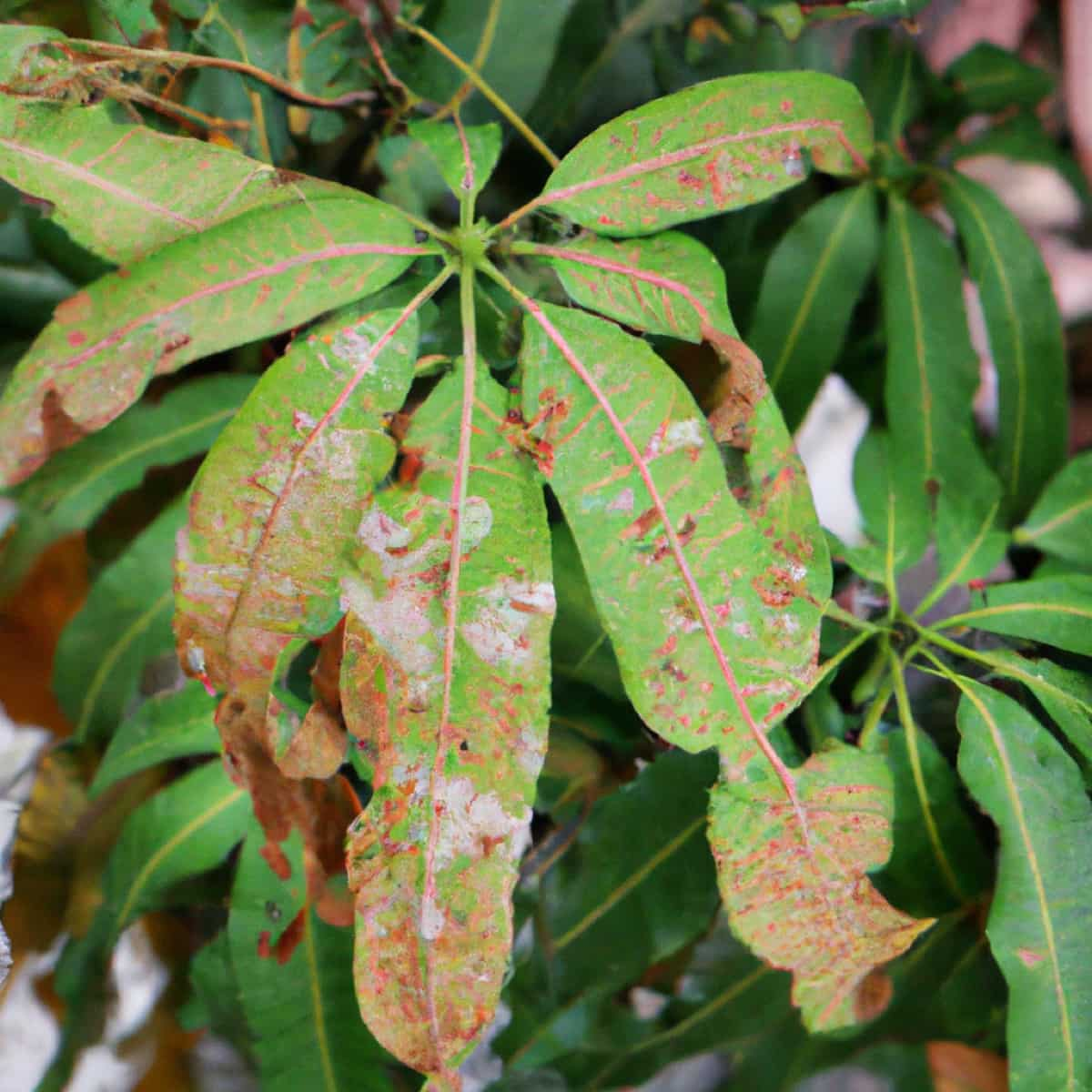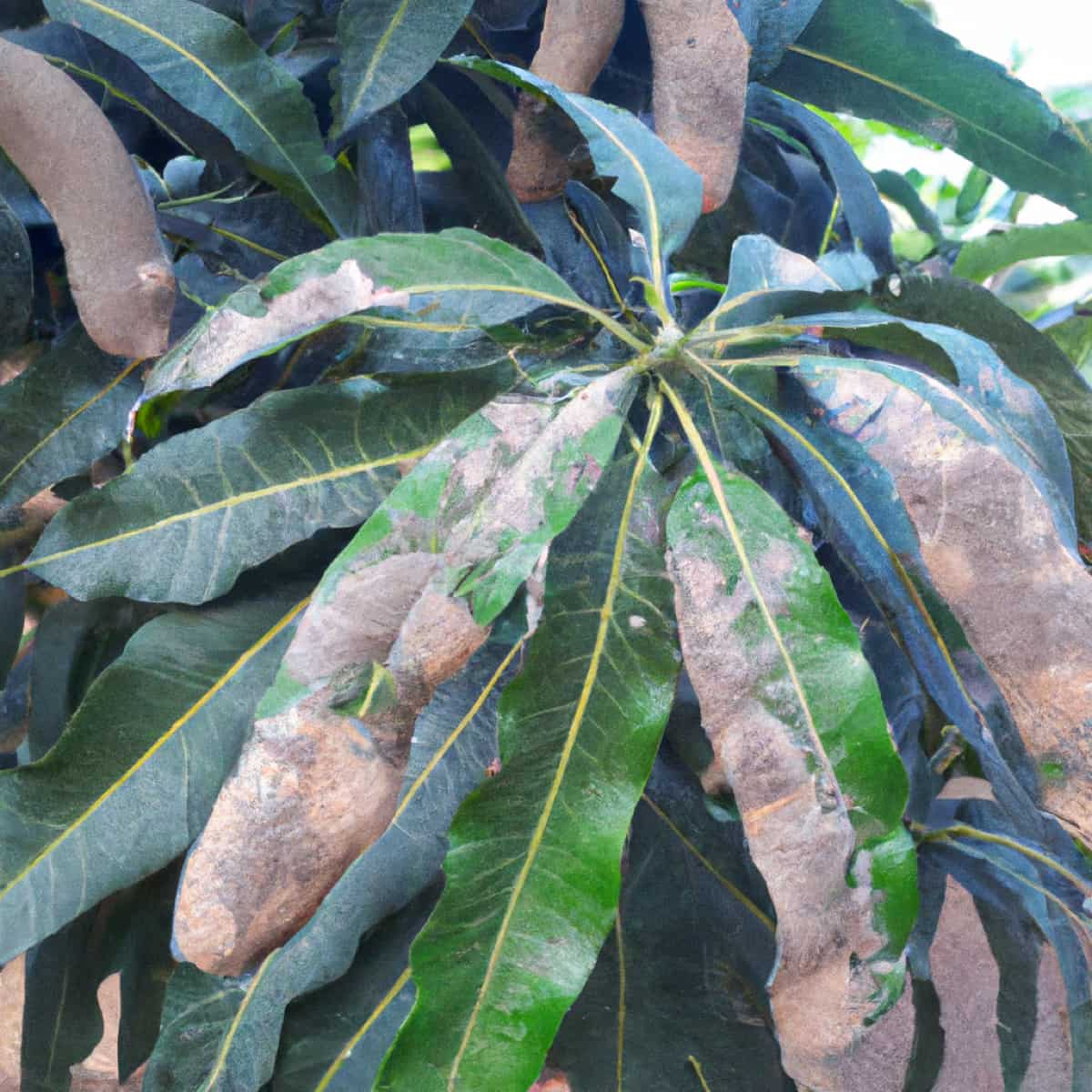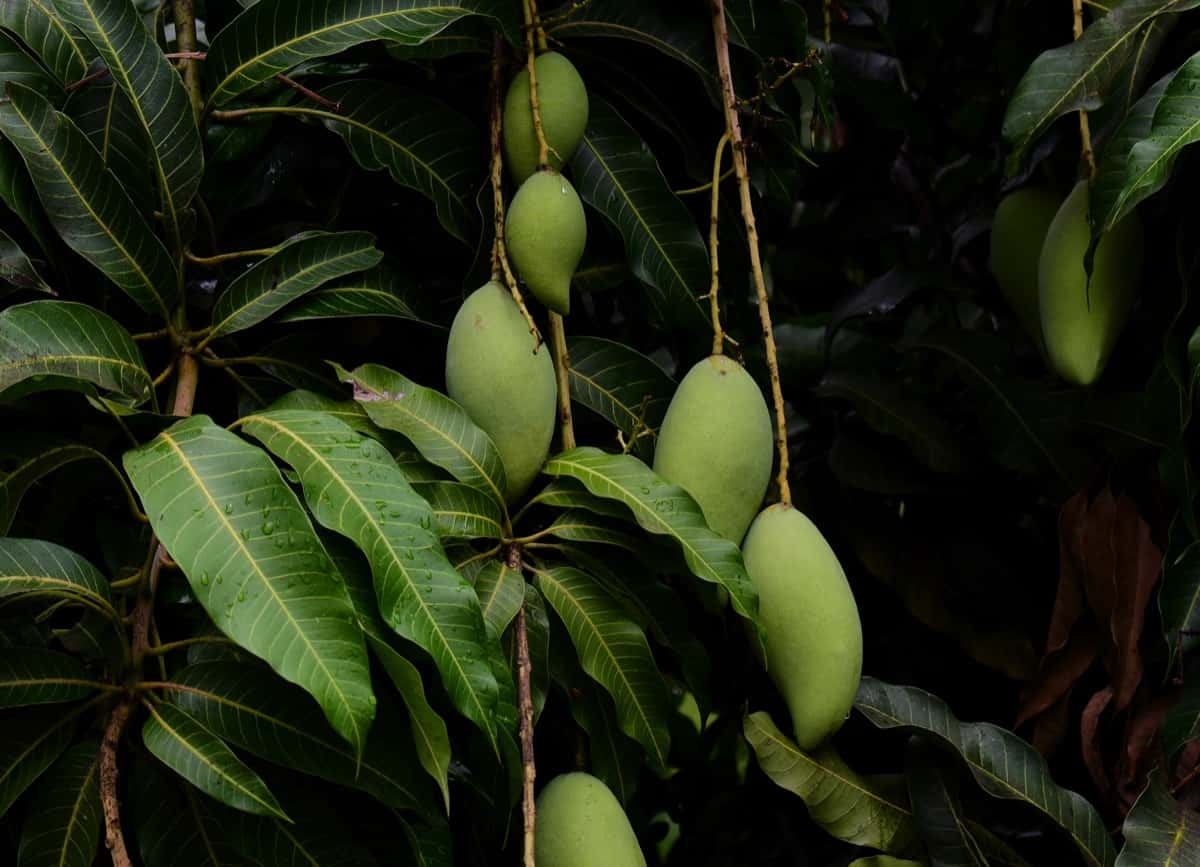The Mango Powdery Mildew Disease is a fungal disease caused by the pathogen Oidium mangiferae, also known as Acrosporum mangiferae. The fungus primarily affects the foliage and fruit of mango trees and can cause significant damage to the tree canopy and fruit yield. Infected trees are also more susceptible to other diseases and pests.

Management of this disease is complex and requires a combination of pruning and removing infected parts, fungicide applications, and cultural practices such as avoiding overhead irrigation, resistant varieties, and crop sanitation. To effectively manage this disease, it is important to understand its disease cycle, the mode of disease spread, and the best methods for controlling it. This article will provide an overview and discussion of the Mango Powdery Mildew Disease in Mango crops, including its symptoms, identification techniques, and control.
Mango Powdery Mildew Disease Management
The Causal Organism of Mango Powdery Mildew Disease
- Oidium mangiferae is an obligate parasite that belongs to the Family Erysiphaceae of Order Erysiphales of the Phylum Ascomycota. Its mycelium is ectophytic.
- Conidia are uni-cellular, barrel-shaped, and produced in bead-like chains. These spores are produced in the spring and cause infections.
- Conidiophores are transparent and short-sized.
The Disease Cycle of Mango Powdery Mildew Disease
The disease cycle of the Mango Powdery Mildew Disease, Oidium mangiferae, in Mango Crops begins when the fungus produces small, powdery conidia (spores) on the surface of the infected plant. These spores are spread by wind, water droplets, and insects and can spread quickly to other parts of the plant. The spores then germinate, forming mycelium (mushroom-like structure), which penetrates the surface of the leaves and petioles to cause infection.
As the infection spreads, the fungus produces white, powdery colonies of mycelium on the surface of the leaves and petioles. These colonies release more spores that the wind can carry to neighboring plants, continuing the cycle. The next cycle stage involves the production of cleistothecia, which are spherical, black bodies found on the powdery colonies. These cleistothecia contain ascospores, which can survive harsh environmental conditions and can be spread to other plants, thus perpetuating the cycle.
The final stage of the disease cycle occurs when the ascospores are released and then germinate on the surface of the foliage. This results in the formation of new hyphae, which penetrate the surface of the leaves and petioles. The fungus then produces more colonies of powdery white mycelium and releases more spores, thus completing the cycle and allowing the fungus to spread and cause damage to the crop.
Occurrence of Mango Powdery Mildew Disease in Mango Crop
- Location of Mango Powdery Mildew disease: This disease occurs in mango crops in India, Bangladesh, Africa, the United States, Mexico, Brazil, Peru, and Ecuador.
- Host range: The most common crops affected by Mango Powdery Mildew Disease are mango, guava, citrus, apple, peach, pear, and loquat.
Favorable Conditions for Mango Powdery Mildew Disease Spread in the Field
- Warm, humid weather, rainy season, and cooler night temperatures at the flowering stage favor the disease transmission
- The fungus grows rapidly in high humidity, cloudy weather, heavier rains, and morning mist.
- The fungus survives as dormant mycelium in the affected leaf buds. The secondary spread of the infection is by air-borne conidia.
- The disease is also favored by overcrowding of plants and poor air circulation in dense plantings. And heavy nitrogen fertilization can cause an increase in the number of spores, leading to an increased risk of infection.
Damage Symptoms of Mango Powdery Mildew Disease
- The disease is characterized by white, powdery spots on leaves, panicles, flowers, and fruits.
- Symptoms of the disease include white powdery lesions on the leaves and fruits, as well as yellowing, defoliation, and premature fruit & flower drop, which leads to the prevention of fruit set
- As the disease progresses, the fungal patches coalesce to form larger purplish brown patches significantly on the upper leaf surfaces.
- The affected fruits will drop prematurely even before attaining pea size.
In case you missed it: Shoot Gall Psyllid Pest Management in Mango: Symptoms, Treatment, Chemical, Biological, Natural, and Organic Control

Percentage of Yield Loss due to Mango Powdery Mildew Disease in Mango Crop
- The disease has caused 10% yield losses in the United States. In Mexico, yield losses are 30%. In India, the yield loss is 70%. In Bangladesh, it is between 20-60%. In China, a 10-50% yield loss is seen. In Thailand, it is 40%.
- In Africa, yield losses are between 15-50%. In the Philippines, it is 30%. In Brazil, it is 20-60%. The Economic Threshold Level is determined at 1-2 infected leaves per plant.
Cultural Control measures of Mango Powdery Mildew Disease
- Sanitation: Removing and destroying debris, such as infected leaves, fruit, and diseased twigs from the orchard, can reduce the inoculum levels.
- Pruning and thinning out: Removing diseased branches and thinning overcrowded orchards can reduce the inoculum levels and increase air circulation and light penetration.
- Crop rotation: Rotating mango with other non-host crops can help reduce the risk of disease incidence.
- Roguing out: Removing and burning the infected plants is necessary to prevent the spread of this disease throughout the field.
Biological Control measures of Mango Powdery Mildew Disease
- Trichoderma harzianum or Gliocladium virens fungus is applied to the surface of the mango crop as a spray or dust and effectively controls the disease.
- Bacillus subtilis bacterium produces antibiotics called bacillomycins, which inhibit the growth of the pathogen and prevent it from infecting the mango crop.
- Mango leaf curl virus can also control mango powdery mildew. These viruses infect the pathogen and prevent it from reproducing.
Chemical Control measures of Mango Powdery Mildew Disease
- The common fungicides used to control powdery mildew disease in mango are Wettable Sulphur, Carbendazim, Karathane, Tebuconazole, Tridemorph, Dimethomorph, and Copper fungicides.
- Sulphur dusting treatment – Dust the sulphur on the leaves immediately after flowering and again 15 days later.
Organic Control measures of Mango Powdery Mildew Disease
- Applying natural foliar sprays containing fungicides such as neem oil helps to prevent the spores from germinating and attacking the leaves.
- Collect the affected leaves from the orchard and bury them in a pit at one corner of the field to control the disease spread.
Preventive Measures for Control of Mango Powdery Mildew Disease
- The plants should be spaced out in the field to ensure adequate airflow between them so that the disease does not infect the healthy plants on contact.
- Regularly monitoring fields for signs of disease will help to catch and manage it early before it spreads.
- Planting mango varieties that are resistant to the fungus can reduce the spread and severity of the disease.
- Fertilization should be done in early spring, keeping the soil loose and well-drained to prevent the disease from spreading.
- Removing infected plants and reducing crop density can reduce the spread of the disease.
- Avoiding overhead irrigation and using drip irrigation instead can reduce the spread of the fungus.
In case you missed it: Leaf Webber Pest Management in Mango: Symptoms, Treatment, Chemical, Biological, Natural, and Organic Control

Conclusion
Mango Powdery Mildew is a serious disease of mango crops and can cause significant losses in yields. The disease can be managed by implementing integrated pest management strategies, including fungicides, pruning, and other cultural practices. With proper management, the disease can be successfully controlled, and losses minimized.
- Beneficial Insects in Pest Management
- Natural Solutions for Pest Control in Flower Gardens
- Types of Fungicides Used in Agriculture
- Common Issues in the Fruit Development Stage of Pomegranate Farming
- Fruit Development Issues in Papaya: Easy Solutions and Treatment
- Soil-Borne Diseases and How to Protect Your Plants
- Practices to Prevent Disease Spread in the Garden
- From Wilted to Thriving: How to Treat Root Rot Naturally in Houseplants
- Natural Remedies to Cure Brown Spots on Fig Tree Leaves